Snow White and the Huntsman
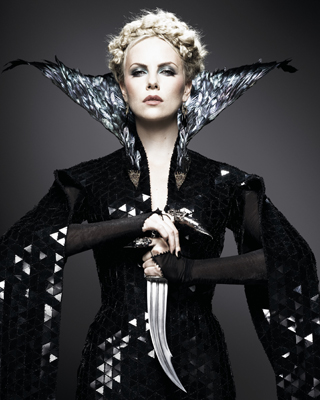
Snow White and the Huntsman
Cast: Kristen Stewart, Charlize Theron, Chris Hemsworth, Sam Claflin
Director: Rupert Sanders
Genre: Action, Adventure
Rated: PG
Running Time: Action, Drama, Adventure
Synopsis: In the epic action-adventure Snow White and the Huntsman, Kristen Stewart (Twilight) plays the only person in the land fairer than the evil queen (Oscar® winner Charlize Theron) who is out to destroy her.
But what the wicked ruler never imagined is that the young woman threatening her reign has been training in the art of war with a huntsman (Chris Hemsworth, Thor) who was dispatched to kill her.
Sam Claflin (Pirates of the Caribbean: On Stranger Tides) joins the cast as the prince long enchanted by Snow White's beauty and power.
The breathtaking new vision of the legendary tale is from Joe Roth, the producer of Alice in Wonderland, producer Sam Mercer (The Sixth Sense) and acclaimed commercial director and state-of-the-art visualist Rupert Sanders.
Release Date: June 21st, 2011
Website: www.snowwhiteandthehuntsmanmovie.com
Shrinking the Talent: VFX and SFX of the Dwarves
Rupert Sanders considers himself to be a practical director who isn't interested in visual effects for the sake of them. He'd rather use VFX to enhance what has already been captured manually on camera. During the shoot, an astonishing 90% of footage was taken on physical sets or on location with limited green screen. However, one of the biggest challenges for Sanders and director of photography Greig Fraser was shooting the dwarves on camera, but having them appear smaller alongside the other cast members.
Several different techniques were used to produce the specific looks for these characters on screen. One potential solution came from one of the production's VFX supervisors (and additional 2nd unit director), Cedric Nicolas-Troyan, a longtime collaborator of Rupert Sanders'. "An effects supervisor tries to find the technical solution to a creative problem," explains Cedric Nicolas-Troyan. "I had to come up with ideas of how to show well-known actors as characters half of their normal size."
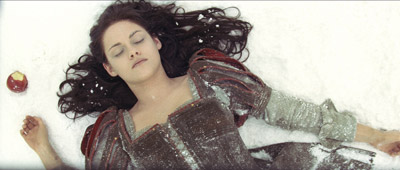 Cedric Nicolas-Troyan wowed the director, the producers and the studio with a test reel of a concept he had designed to "shorten" the legs of the cast. Though this would make the actors appear smaller on screen, using it for all the shots needed would blow the budget and time frame…and make it improbable to hit the film's release date. "We couldn't use visual effects every time we see a dwarf, or we'd be dead in the water and never make our days," says Cedric Nicolas-Troyan.
Cedric Nicolas-Troyan wowed the director, the producers and the studio with a test reel of a concept he had designed to "shorten" the legs of the cast. Though this would make the actors appear smaller on screen, using it for all the shots needed would blow the budget and time frame…and make it improbable to hit the film's release date. "We couldn't use visual effects every time we see a dwarf, or we'd be dead in the water and never make our days," says Cedric Nicolas-Troyan. The VFX supervisor had long ago learned that there's more than one way to get the job done. He reflects: "We used some very old-school techniques, like rostrums [platforms], which help fill the gaps in the viewer's mind. In some scenes, we would shoot the actor and shrink his legs, and in others, we used a face replacement."
Visual effects producer Lynda Thompson adds: "It's also about the framing of the shot: If you don't see the actors' feet, they appear to be walking on ground level. Principal actors for dwarves are walking about two feet below them, so the framing of the shot makes them appear shorter. This really helped to solve being able to crack on with the shoot in camera."
On wider shots, shorter doubles for the actors were dressed and made up to look like the principal characters, which is another great way of saving time and allowing the director and cinematographer to shoot physically. Lynda Thompson says: "However, there are some scenes where we have the doubles or stunt doubles close up and you can tell it's not a principal actor, so those were our true print face replacements."
Dwarf Prosthetics and Designs
For both the principal actors and their doubles, the daily routine of getting camera-ready sometimes began as other cast and crew were coming home from a night out. Due to the amount of prosthetics, hair and makeup-under the supervision of hair department head Luca Vannella and makeup department head Sharon Martin -and costumes that needed to be applied and donned, some of the actors and key crew were up extremely early in the morning.
Prosthetics designer David White drew his initial designs by taking Rupert Sanders' lead with what his director did-or more to the point-did not want from his dwarves. "Rupert Sanders didn't want pointy ears or big chins and that over-the-top fantastical element," remembers David White. "His angle was very different, but his vision was quite extraordinary." David White gave Rupert Sanders mock-ups of each of the characters for his input, and they would discuss looks and alterations. Commends White: "Rupert Sanders takes you on a road that is so clear that you just have to follow. It totally works."
White was responsible for the visual enhancement of the dwarves, accentuating certain features of the actors through detailed prostheses. These were not always to the extreme, but enough to make each one of them unique. He explains: "It was a question of getting all of the actors on board before it was established how we were going to handle certain aspects. I haven't seen dwarves quite like this before, but they work so well in the movie."
By using silicone bases, David White and his team ensured that the actors were able to act through their prosthetics. "These prosthetics are so thin that actors can move underneath; they are very flexible," says the designer. "However, the dwarf doubles are a different story, and a completely different build in terms of prosthetic makeup."
The principal actors' doubles needed to have prosthetics applied to make them look just like the actors. However, size and head-shape differences required a completely different set of prosthetics. "Some of the doubles' prosthetics are more masklike, but still very thin and flexible and practical," comments David White. "We accommodated all of the different elements and copied the principal actors' looks-with all of their prosthetics-on to another person who was a totally different design. It's a good thing all of our characters are such strong designs; they read from a distance and look fantastic. I'm amazed how close the camera can actually get to them."
All of the dwarves had different prosthetic designs, makeup, hairstyles and facial hair. Therefore, the actors were normally in the prosthetics trailer as early as 2:30 or 3:00 a.m. "There were a lot of different processes to get them camera-ready, and there was an enormous amount of jumping around with eight dwarves in one trailer," laughs David White. Not enough work? With eight dwarves and eight doubles, the crew had a minimum of 16 dwarves on a given workday, not taking into account any stunt doubles or stand-ins needed for certain scenes.
Considering the amount of time these performers had to sit in their respective chairs, David White put a great deal of consideration into which artist from his department would be assigned to each actor, and where the actors were positioned within the trailers. "I don't think I've ever had a trailer full of British actors of that caliber; it was quite extraordinary," says David White. "There was a lot of banter and a great vibe, but all of the gentlemen have a discipline when it comes to work and were good sports about coming in so early. They each had their different ways of dealing with it-some napped, some read, some listened to music…all sorts of tricks were used to get by."
Despite the prep work, the actors who portray the dwarves were up for the challenge at hand. "It was tough but when we finished and you saw the quality of their work, you knew it was worth every second," says Ray Winstone. "Genius."
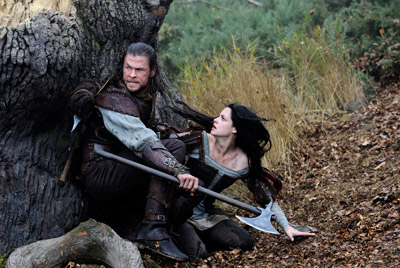 Prosthetics used to be made from the standard foam latex, but as the material is so dense and has no translucency whatsoever, it has to be painted to create an effect. Because the use of latex puts more pressure on the lighting scenarios, silicone is the preferred material of the day. White commends its fantastic qualities, noting, "We can change the density and the color to get it exactly right for the actor or actress."
Prosthetics used to be made from the standard foam latex, but as the material is so dense and has no translucency whatsoever, it has to be painted to create an effect. Because the use of latex puts more pressure on the lighting scenarios, silicone is the preferred material of the day. White commends its fantastic qualities, noting, "We can change the density and the color to get it exactly right for the actor or actress." With a minimum of eight principal dwarves and eight doubles all needing prosthetics for each new shooting day, White and his team created more than 400 different sets of prosthetics for all of these artists…and that went up by the day. For example, if every single eyebrow on a principal prosthetic was manually punched 300 times, that resulted in 600 punches on every single piece…times 400!
Learning Movement
As the costume, hair, makeup and prosthetics departments all had to deal with the trials and tribulations of marrying the images of the principals with their doubles, so did Peter Elliott. The established movement director has worked on more than 50 features including such classics as Gorillas in the Mist: The Story of Dian Fossey and Greystoke: The Legend of Tarzan, Lord of the Apes and recent marvels such as Where the Wild Things Are and The Hitchhiker's Guide to the Galaxy.
Peter Elliott's challenge on this film was to teach the principal actors and their respective doubles how to all match the manner in which they move. To do this he collaborated with the cast to invent a walk that was achievable by both actors playing the same role. Then, each pair had to learn to walk in a manner that was unique to their particular character.
"I was given three weeks during which we had intense rehearsals," recalls Peter Elliott. "I started with the doubles, just to get the generic framework, then took our principals and worked on walks. People do not realise how hard it is to change something as integral as the way you walk…and then make it look and feel completely natural. It was a tight time frame to get it ready, but we managed it in the end."
One of the most intrinsic things that the actors changed for their walks was their center of gravity. "When we sit on two legs, our center of gravity is completely balanced and in the middle," shares Peter Elliott. "To release the weight from one leg to take a step, we lean backwards slightly, which releases our weight to put the other leg forward. Our center of gravity is continually and very minutely going backwards and forwards."
This was quite different among the taller and shorter actors. Says Peter Elliott: "Our doubles had a whole different way of walking. Their legs are shorter, and they don't have the same distance our principals do in which to achieve that. So they change their center of gravity from side to side, which creates a natural twist in their walk."
It was quite a new experience for our new band of dwarves. "We had to go to dwarf college," recounts Frost. "Peter Elliott, who is one of the best movement coaches in the world, trained us to walk in a particular way for what seemed like weeks and weeks. There was a joke amongst the dwarves on set. You'd just hear someone cry out 'small steps,' which is exactly what Peter Elliott shouted at us constantly for weeks while hitting us with bamboo."
Clothing the Dwarves
Once the principals and doubles had been through prosthetics, hair or wig application and makeup, they were finally ready to get into costume. "The dwarves were one of the main challenges for me, as each of those characters had a personality," says Colleen Atwood. "Mathematically it was simple because it was all about proportion, but if I managed to get the head-and-shoulders ratio right between a principal and his double, I couldn't make the body thing work. We ended up using body suits on some of the actors and doubles to make the bodies correspond, and then exaggerated the dwarf quality in the principal actor."
The body suits had to be specifically designed to re-create the body shape of each principal actor and his double. Indeed, they were intended to change the methodology of the actor. The costume design became an incredibly important part of the technicalities behind the suit design, which can appear to lower the crotch and change the shapes of the arms, legs and body.
Even though this story exists in a fantastical world, it was still grounded in a time period that one could believe. From the beginning of preproduction, Atwood collaborated with Rupert Sanders, prosthetics and the hair and makeup teams to achieve this feat. The costume designer says: "Rupert Sanders talked to us all about how he wanted Snow White and the Huntsman to be a bit edgier than just a fairy tale."
If you look close enough, you'll notice that Colleen Atwood subtly incorporated the characters' personalities into the costumes. "Duir and Coll are the buddy trailblazers," explains Colleen Atwood. "They have a rustic frontier, so we needed to give them weapons. Muir and Quert have a more demure, spiritual side to them. Nion is outgoing and comedic, and then we have the salty dogs, Beith and Gort. The concept was that all of these guys are magpies, they steal and stash treasure all over the woodlands, but also carry a bit of bling under their coats."
Mirror Man and Enchanting Creatures: Additional VFX of the Epic
The dwarves were not the only characters upon which several department heads had to collaborate. While Rupert Sanders likes to keep as much of his shooting in camera as possible, there are many things that need the helping hand of visual effects wizardry to enhance and elevate a character or scene. To create Rupert Sanders' vision of the world we see in Snow White and the Huntsman, the director and executive producer Borders enlisted the help of eight accomplished vendors from across the globe.
Visual effects producer Lynda Thompson discusses what drew her to such a massive labor of love: "I remember my first meeting on this film was with Rupert Sanders and Cedric Nicolas-Troyan about the tone poem that Rupert Sanders wanted to put together. It was a sales tool in a sense, but it wowed the studio because it was a great tonal guide and an insight to what Rupert Sanders wanted to achieve. Honestly, it was amazing. It really excited me about the movie and whilst I had planned to just prep the movie, I found that I couldn't stop working on it because it just blew me away."
Given her time frame, it was important for Lynda Thompson's team to have different vendors concentrate on each area. They were able to divide up the work fairly easily, as the film naturally splits by characters and areas of expertise from different houses-all picked because of their reputations for being top of their game. These included such work as the creation of the dwarves, the Enchanted Forest creatures, the good fairies, the dark fairies, set extensions, face replacements, character aging and transformations and, of course, the Mirror Man.
Under the supervision of VFX supervisors Cedric Nicolas-Troyan and Philip Brennan, the houses achieved the following: Rhythm & Hues accomplished work on the dwarves, Enchanted Forest creatures, CG good fairies, CG bridge troll, CG magpies and CG ravens; Double Negative Visual Effects helped to create Dark Forest creatures (including dark fairies) and the intricate shard visual effects when Ravenna's Shadow Army splinters; Pixomondo worked to create Ravenna's Shadow Army, as well as assisted with crowd duplications and set extensions; The Mill developed the Mirror Man; BlueBolt crafted King Magnus' castle (and the castle it becomes under Ravenna's rule), as well as coordinated set extensions, digital matte paintings and CG fireballs during Ravenna's attack on an advancing army; BaseBlack conducted digital matte paintings and set extensions; Lola VFX helped to imagine the dwarves, coordinated Ravenna's face aging and face replacements and VFX of Snow White in her frozen state; and Hydraulx created CG swords and conducted work on Ravenna's transformations.
Within Ravenna's mirror chamber is the iconic magic mirror resting against the wall. This cherished-but-cursed relic has, over time, grown to become a physical entity. Ravenna is so obsessed with her own image that the mirror reflects a manifestation of her soul and her dark subconscious. Indeed, it allows the mirror to reveal what Ravenna truly has become. The mirror tells her what her subconscious knows and reveals a truth that she lets no other person witness.
The inspiration for Rupert Sanders' Mirror Man was a sculpture called "Face-Off" by the talented London-based Irish artist Kevin Francis Gray. "As we needed to capture Ravenna's reflection in it on the camera, we had to create a fake standing Mirror Man so that she could see herself in it," explains Cedric Nicolas-Troyan. "It's entirely computer generated by a team at The Mill, and he's never fully solid and never fully liquid. That was on purpose to reflect Ravenna's character that is always changing…and not necessarily in a good way."
So, does the Mirror Man actually exist? Is Ravenna the only person who sees him? Rupert Sanders and the producers would like for the audience to believe what they choose to believe.
The eight houses weren't the only ones with tricks up their sleeves. Special effects are stamped all over the film, especially in the wintery world of Ravenna's creation. For example, for the drops of blood spilled upon the snow by Snow White's mother, Sanders thought the fake blood looked too fake. An easy solution? The director had the FX guys actually draw his own blood to use as the blood that appears on the snowy land.
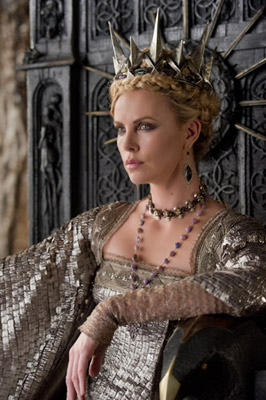 Dark Castles and 800-Year-Old Oaks: Set Design and Locations
Dark Castles and 800-Year-Old Oaks: Set Design and LocationsThe world in which Snow White lives was designed and created by The Bourne Supremacy's Dominic Watkins, almost entirely on sets at Pinewood Studios in Buckinghamshire in the U.K. It was important for Sanders to have physical sets to shoot on, a rare treat for cast and crew who work on many productions that rely on huge green-screen stages to re-create their biggest sets.
As one might imagine, production was massive. Commends Rupert Sanders of his production designer's work: "Dom Watkins did an incredible job with the amount of sets we had. We'd laugh at the amounts of work. Every weekend, there would be another three or four sets he'd have to build. Pinewood became like a maze from above. You'd walk through Hammond's castle and go into Ravenna's castle. You'd walk through that onto the troll bridge. While the troll bridge was being remade into the icy waste, there would be a village there. Everything was literally stacked in. Dom Watkins had an incredible time trying to manage that financially, creatively and practically. It was huge."
Of the 23 or so sets built at Pinewood, the most massive was the impressive royal castle, once belonging to King Magnus before Ravenna usurped his rule, killed him and drained life from the kingdom. The foreboding castle was built in an auto park by the entrance to Pinewood Studios, dominating the skyline for the 24 weeks it took to create and the four weeks it was used for filming.
"It was our biggest single spend and the first set we had to crack on with, as it was a design bolted into the concept of the castle interior and exterior," says supervising art director Dave Warren. "Dominic Watkins and Rupert Sanders had the concept in mind that the castle could only be approached by a causeway from a beach, and we found a beautiful beach with an island on a rocky isthmus peninsula…so the design of the castle grew."
The beach Warren references is Marloes Sands in Pembrokeshire in Wales, where the main unit spent an entire week filming Kristen Stewart as Snow White, Chris Hemsworth as the Huntsman and their rallied troops during an epic battle. These beach scenes played out against a stunning background. The rocks on the beach are unique in the manner in which they tilt, so the art department "squeezed" some of the rocks to form a mold. This technique allowed them to re-create the look on the castle interior at Pinewood.
An explanation of the technique: To squeeze, the area required was painted with layers of silicone and a layer of material similar to netting; this was then allowed to set. This mold was backed with plaster or foam for support and transported to the workshop at Pinewood Studios. The silicone mold was then used to re-create the desired shape or texture. Other squeezes include Tretower Village stone and slate, wall texture at a local church in Iver and the columns at St. Bartholomew's Church in London.
More than 2,000 square feet of plaster stonework (polystyrene) and 700 sheets of various textured rocks were used to create both castles on the Pinewood back lot: King Magnus' and the castle that belongs to Duke Hammond.
The royal castle goes through various stages over time. During Magnus' reign, colorful flags donned the walls, courtiers are dressed in bright colors, trees blossom and flowers bloom. After his untimely demise, the castle was redecorated to Ravenna's dark standards. Thoroughly black and as toxic as the heart that beats inside of the wicked Queen, the grounds are covered in dead vines and the walls are bedecked with torn and ragged blood-red flags.
The vines used to decorate the sets we find during Ravenna's reign are called liana vines. They were grown in Malaysia especially for the production and were shipped over to the U.K. for use during filming-ultimately delivered to Pinewood in a 40-foot sea container.
Due to the unpredictable nature of every shooting schedule, the art department had to change the look of the castle several times. In order to complete Rupert Sanders' required shots, they went from the Magnus-to-Ravenna look to the Ravenna-to-Magnus look during production. Each transformation took an incredibly short amount of time (only two and a half days) for the department to accomplish the complex transitions. Naturally, it required a good deal of working around the clock for a quick turnaround.
To give the reader an idea of the amount of prep work that went into the set design and eventual build, here are some staggering statistics. Approximately 15,000 artificial apple blossoms were used to cover an apple tree in the castle courtyard. Almost 60,000 hog rings were used to attach the blossoms to this tree. More than 1,500 trees, ranging in height from three to ten meters, were incorporated into the production. All of these trees have been used as part of the Black Park Forestry Program to restore the park to its prewar period. Approximately 3,000 faux floor slabs were produced, and the tree in the Enchanted Forest was constructed of 2,317 individual steel pieces.
Sam Mercer was moved by Rupert Sanders' fascinating decisions. The producer commends: "Rupert Sanders' approach to the film design is that everything is just slightly enhanced or slightly taken into that fairy-tale zone. Just so it doesn't feel too common and too familiar, yet it still put you in the right place and mood. For instance, scale was really important to him. It's not like Snow White or the Huntsman just go by any tree: they walk by a 200-foot tree. It's not just that the branches are normal. The branches are creepy and make Snow White's journey through the forest edgy and creepy. It pushes our reactionary zone up just a little bit further-making us more on edge."
In addition to constructing Duke Hammond's castle on the back lot, production designer Dom Watkins, art director Warren Haigh and their teams set about building the royal village, which was originally penciled to be shot on location in Wales. Due to logistics, to set decorating needs for various stages and to allow for more control over the shoot, a village had to be constructed. As with the castle, the village goes through two stages during the two reigns. Magnus' village is a brightly colored, prosperous community, whereas Ravenna's is a torched, ruined and run-down dwelling with a feeling of the crepuscular hour.
On a lighter note, the straw that was used in Snow White and the Huntsman is an ancient variety, grown especially for thatching roofs in Somerset. It was harvested in the traditional fashion using 1920s machinery. Humorously, the local pigeons discovered the thatching on the village set and descended to Pinewood, en masse, at about 5:10 p.m. to feast on the corn heads.
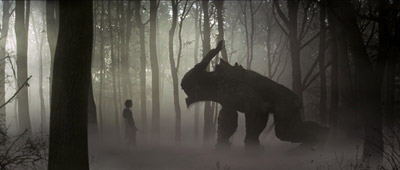 While the superior set designs of Dominic Watkins wowed those who laid eyes upon them, his team's ability to turn a scrap of land, a clearing in the marshes or a normal part of the forest into something quite spectacular is unparalleled. They morphed familiar shooting locations into unrecognisable and beautiful set pieces. Who could have guessed that two mounds of earth on the back lot at Pinewood could become a troll bridge, or that a formerly dull, green part of parkland could transmogrify into the Enchanted Forest?
While the superior set designs of Dominic Watkins wowed those who laid eyes upon them, his team's ability to turn a scrap of land, a clearing in the marshes or a normal part of the forest into something quite spectacular is unparalleled. They morphed familiar shooting locations into unrecognisable and beautiful set pieces. Who could have guessed that two mounds of earth on the back lot at Pinewood could become a troll bridge, or that a formerly dull, green part of parkland could transmogrify into the Enchanted Forest? Several locations were used for both the Enchanted Forest and the Dark Forest including Bears Rails in Windsor Great Park, the Queen's backyard. Roth acknowledges that he was amazed by how they were able to capture the scenes. He notes: "We shot the Enchanted Forest on the Queen's land. It's a beautiful area behind Windsor Castle, and the deer and elk that roam there can be traced to Henry V. We shot around trees that are centuries old."
Bears Rails was chosen for its ancient wood pasture, which is full of 800-year-old oak trees, mainly used for ship building in days long gone. Burnham Beeches, Langley Park and a filming regular, Black Park (adjacent to Pinewood Studios), also formed part of the journey through Sanctuary and the Dark Forest. Additionally, a familiar location, Bourne Woods, played host to the epic battle scene at the beginning of our story when King Magnus rescues Ravenna…only to be betrayed the next day by the eternal beauty.
Charlize Theron Interview for Snow White and the Huntsman
www.girl.com.au/charlize-theron-snow-white-and-the-huntsman.htm
MORE



